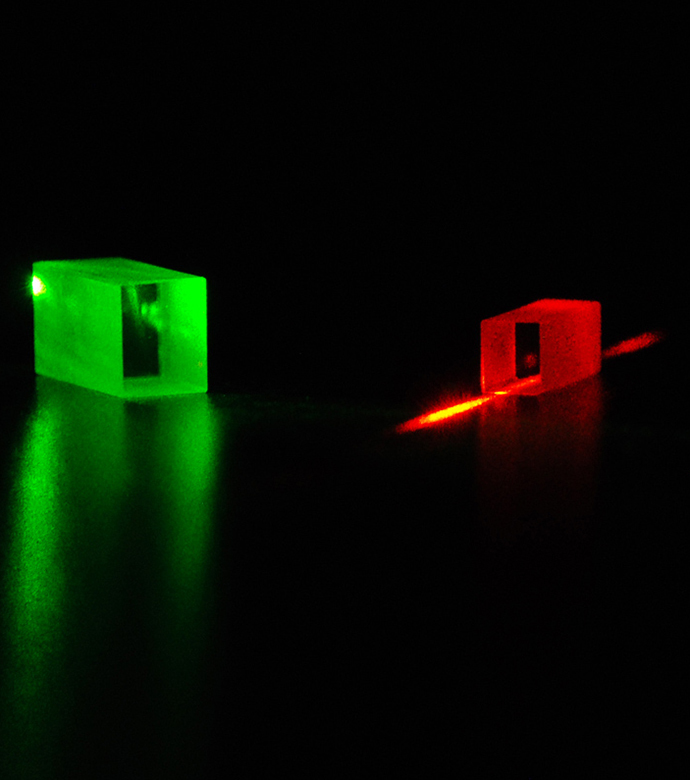Secure Optical Quantum Communications
communications
Secure Optical Quantum Communications (LEW-TOPS-108)
Novel production and use of entangled-photon pairs enhances quantum communications capability
Overview
NASA's Glenn Research Center has developed a method of using entangled-photon pairs to produce highly secure mobile communications that require mere milliwatts of power. Conventional gas Argon-ion laser sources are too large, expensive, and power-intensive to use in portable applications. By contrast, Glenn's patented optical quantum communication method produces entangled-photon pairs approximately a million times more efficiently than conventional sources, in a system that is small and light enough to be portable. Furthermore, because this method transmits digital information by detecting small temporal shifts between entangled photons, its superior signal-to-noise ratio facilitates highly secure communications in very noisy free space and fiber-optic environments. Originally developed for micro-robots used for deep space exploration, this technology represents a breakthrough for a wide variety of terrestrial, scientific, military, and other field-deployable applications including fiber-optic and satellite communications.
The Technology
In the prior art, the systems that produced photon pairs took up a great deal of space on a laboratory table, weighed several hundred pounds, consumed tens of kilowatts of electrical power, and required cooling water. These limitations greatly restricted the utility of quantum communications systems, which rely on these photon pairs. To address this issue, Glenn's innovators developed a novel system that uses a laser source, a pair of nonlinear crystals in optical contact with each other, and a fiber coupling point configured to receive a pair of single mode fibers. Pairs of polarization-entangled photons are produced through spontaneous parametric down conversion of the laser beam and provided to the fiber coupling point. The optical signal is coded at the transmitter by modulating the inter-beam delay time between pairs of entangled photons. The inter-beam delay will determine whether the photon pairs are absorbed by a fluorescer in the receiver. When absorbed, the photon pairs cause a fluorescent optical emission that a photon detector identifies. One advantage of this system is that it eliminates the need for a coincidence counter to realize the entanglement-based secure optical communications, because the absorber acts as a coincidence counter for entangled photon pairs. In addition, this modulation spectroscopy technique is ultra-secure since the delay times are very short (femtoseconds) and unresolvable by conventional photon detectors. Finally, the system uses solid-state, monolithic construction that allows for cost-effective batch-manufacturing techniques. This technology represents a significant breakthrough in the fields of communications, optics, cryptography, and surveillance.


Benefits
- Highly secure: Hides secure code in the difference of the entangled-photon pair, making interception impossible, even with current state-of-the-art technology
- Efficient: Transmits information at very low power levels (less than a nanowatt), while using a limited number of photons
- Versatile: Can be used in free space and with fiber optic cables
- Economical: Permits the use of low-cost, off-the-shelf optical coatings and components
- Compact and transportable: Enables numerous in-field applications not previously possible
Applications
- Fiber optic communication systems
- Free-space laser communication systems
- Satellite communications
- Defense technologies
- Airborne communications
- Surveillance systems
- Communications between micro-robots
- Unmanned aerial vehicle surveillance communications
- Secure line-of-sight optical communication links
Similar Results

Boosting Quantum Communication Efficiency
The technology consists of an array of quantum photon sources connected via a sophisticated switching network. This system is designed to produce single pairs of entangled photons at a high rate while actively suppressing the generation of multiple pairs. The key innovation lies in its ability to detect and eliminate instances where two or more entangled photon pairs are generated, effectively reducing noise in the quantum system.
The technology operates by providing a heralding pulse that notifies the external system of successful entangled photon generation. When multiple pairs are detected, they are prevented from entering the rest of the system, thereby maintaining the integrity of the quantum information.
By combining multiple single-photon sources through its switching network, the technology not only reduces noise but also increases the overall single photon pair generation rate. This dual approach of noise reduction and increased generation efficiency improves qubit transmission rates, potentially by a factor of 10 to 100 over current methods.
While still in the early stages of development, the source array represents a significant advancement in quantum communication systems. It addresses the critical need for high-fidelity entangled photon sources, which are essential for various quantum applications, including entangling sensor networks, quantum computer networks, and quantum key distribution for secure communications.
As quantum technologies continue to evolve, this source array technology positions itself as a crucial component in the development of large-scale, efficient quantum networks, offering a solution to one of the fundamental challenges in quantum information transmission.

Optical Transceiver Method of QKD Encryption Suite of Technologies
The core of the technology is the SAW division de-multiplexing method (LEW-19920-1). It uses a commercially available double-clad fiber optic cable with a 9um core and a 105um first cladding. By optimizing the wavelengths of the QKD photon and data transmission, a single focusing lens can create a diffraction pattern that directs the QKD photons to the 9um core and the data signal to the 105um secondary core.
Key components of the system include:
• SOA Driver With Wideband Current Control (LEW-19913-1): This device allows a semiconductor optical amplifier (SOA) or laser to be driven with an arbitrary current at a rate of over 100 MHz. This enables the rapid generation of sub-nanosecond laser pulses with one of four polarization states, which is necessary for QKD.
• Random Bit Generator with Linear Feedback Shift Register LFSR Scrambler (LEW-20058-1): This device produces random bits by combining the output of a noise source with a pseudorandom bitstream from the LFSR. This allows a random basis set to be generated on demand for a polarization modulator.
• Variable-length quantum key conversion (LEW-20224-1): Since QKD operations produce keys of varying lengths, a strategy was developed to "digest" these raw keys using a hash function, such as SHAKE256. This process generates a fixed-length output that is useful for symmetric encryption schemes like AES256.
• The system also incorporates a Discretization Algorithm for Numerical Wave Optics Simulations (LEW-20119-1), which can accurately model the effects of atmospheric turbulence on the propagating optical beam.

Optical Tunable-Based Transmitter for Multiple High-Frequency Bands
NASA Glenn's researchers have developed a means of transporting multiple radio frequency carriers through a common optical beam. In contrast to RF infrastructure systems alone, this type of hybrid RF/optical system can provide a very high data-capacity signal communication and significantly reduce power, volume, and complexity. Based on an optical wavelength division multiplexing (WDM) technique, in which optical wavelengths are generated by a tunable diode laser (TDL), the system enables multiple microwave bands to be combined and transmitted all in one unit. The WDM technique uses a different optical wavelength to carry each separate and independent high-frequency microwave band (e.g., L, C, X, Ku, Ka, Q, or higher bands). Since each RF carrier operates at a different optical wavelength, the tunable diode laser can, with the use of an electronic tunable laser controller unit, adjust the spacing wavelength and thereby minimize any crosstalk effect.
Glenn's novel design features a tunable laser, configured to generate multiple optical wavelengths, along with an optical transmitter. The optical transmitter modulates each of the optical wavelengths with a corresponding RF band and then encodes each of the modulated optical wavelengths onto a single laser beam. In this way, the system can transmit multiple radio frequency bands using a single laser beam. Glenn's groundbreaking concept can greatly improve the system flexibility and scalability - not to mention the cost of - both ground and space communications.

The Teletenna - A Hybrid Telescope Antenna System
Initially developed for missions to Mars, Teletenna integrates RF and optical communication technologies to transmit data from deep space to Earth at extremely high speeds. The system combines a co-boresighted telescope and a Ka-band RF antenna to minimize system mass and enhance performance. Designed with an optimal focal length-to-diameter ratio, the apparatus features a classical Cassegrain geometry, including a sub-reflector in front of the RF feed which acts as a mirror for the optical signal while being transparent to the RF signal. The apparatus also mechanically and thermally isolates the RF reflector system from the optics to offer maximum stability.
Teletenna was created to overcome two significant challenges to DSOC: 1) laser inefficiency due to poor alignment during spacecraft disturbances and 2) performance degradation due to lack of rigidity in vibrational environments (such as space). The first challenge is addressed by the telescope portion of this technology, which facilitates the acquisition and maintenance of the link with ease - even in less than ideal conditions. The second challenge is addressed by rigidly fixing the RF reflector to the spacecraft body and attaching the optical section to a vibration isolation platform. The result is a device that can point to within 0.5 degrees of the sun (traditional optical systems are limited to 3 degrees), allowing for approximately 20 extra days of contact time between Earth and Mars. By combining RF and optical communications, this breakthrough innovation has the power to transform communications as we know it.
Glenn welcomes co-development opportunities.

Receiver for Long-distance, Low-backscatter LiDAR
The NASA receiver is specifically designed for use in coherent LiDAR systems that leverage high-energy (i.e., > 1mJ) fiber laser transmitters. Within the receiver, an outgoing laser pulse from the high-energy laser transmitter is precisely manipulated using robust dielectric and coated optics including mirrors, waveplates, a beamsplitter, and a beam expander. These components appropriately condition and direct the high-energy light out of the instrument to the atmosphere for measurement. Lower energy atmospheric backscatter that returns to the system is captured, manipulated, and directed using several of the previously noted high-energy compatible bulk optics. The beam splitter redirects the return signal to mirrors and a waveplate ahead of a mode-matching component that couples the signal to a fiber optic cable that is routed to a 50/50 coupler photodetector. The receiver’s hybrid optic design capitalizes on the advantages of both high-energy bulk optics and fiber optics, resulting in order-of-magnitude enhancement in performance, enhanced functionality, and increased flexibility that make it ideal for long-distance or low-backscatter LiDAR applications.
The related patent is now available to license. Please note that NASA does not manufacturer products itself for commercial sale.



